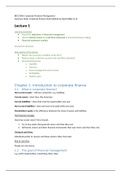Samenvatting
BEC22306 Corporate financial management: summary lectures and book
- Vak
- Instelling
- Boek
Een samenvatting van alle behandelde hoofdstukken uit het boek Corporate Fianance van David Hillier (3e editie) in het vak corporate financial management (BEC22306), plus aanvullende informatie en aantekeningen uit de colleges.
[Meer zien]




